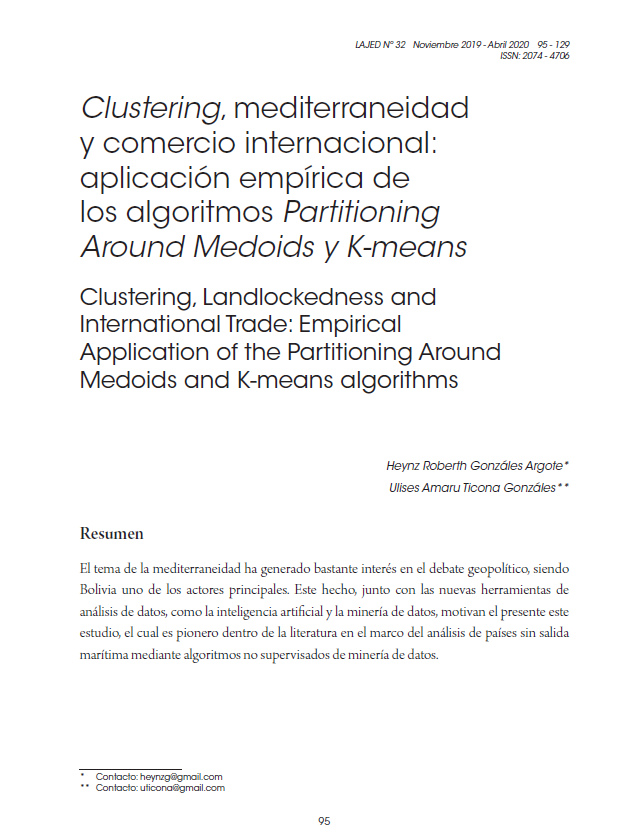Clustering, Landlockedness and International Trade: Empirical Application of the Partitioning Around Medoids and K-means algorithms
DOI:
https://doi.org/10.35319/lajed.201932400Keywords:
Cluster, landlocked countries, littoral, international trade, data miningAbstract
Landlockedness has generated significative interest in the geopolitical debate, particularly in Bolivia. This fact, along with innovative methodologies such as artificial intelligence and data mining, has motivated this research, which is unprecedented in the literature concerning landlockedness analysis through unsupervised algorithms of data mining.
Consequently, the theory of cluster formation is studied and applied through the K-means and PAM (Partitioning Around Medoids) algorithms using international trade information of one hundred eighty-eight countries over a period of ten years, in order to test whether the landlockedness condition is a limiting factor in the commercial dynamics of countries.
The results show that a reduced subset of the landlocked countries, including Bolivia, would have eased restrictions such as international trade costs and times, during the last decade.
Downloads
References
Arvis, J. F., Marteau, J. F. y Raballand, G. (2010). “The cost of being landlocked: logistics costs and supply chain reliability”. The World Bank.
De, Prabir. (2006). “Trade, infrastructure and transaction costs: the imperatives for Asian economic cooperation”. Journal of Economic Integration, 21(4), 708-735.
Driffield, N. y Jones, C. (2013). “Impact of FDI, ODA and migrant remittances on economic growth in developing countries: A systems approach”. The European Journal of Development Research, 25(2), 173-196.
Faster, D. S. (2014). Pentaho Data Integration.
Faye, M. L., McArthur, J. W., Sachs, J. D. y Snow, T. (2004). “The challenges facing landlocked developing countries”. Journal of Human Development, 5(1), 31-68.
Fayyad, U., Piatetsky-Shapiro, G. y Smyth, P. (1996). “The KDD process for extracting useful knowledge from volumes of data”. Communications of the ACM, 39(11), 27-34.
Grigoriou, C. (2007). “Landlockedness, infrastructure and trade: new estimates for central Asian countries”. The World Bank, Development, Research Group.
Kaufman, L. y Rousseeuw, P. J. (2009). Finding groups in data: an introduction to cluster analysis (Vol. 344). Nueva York: John Wiley & Sons.
Lahiri, B. y Masjidi, F. K. (2012). “Landlocked countries: A way to integrate with coastal economies”. Journal of Economic Integration, 27(4), 505-519.
Leiva-Valdebenito, S. A. y Torres-Avilés, F. J. (2010). “Una revisión de los algoritmos de partición más comunes en el análisis de conglomerados: un estudio comparativo”. Revista Colombiana de Estadística, 33(2), 321-339.
MacKellar, L., Wörgötter, A. y Wörz, J. (2000). “Economic development problems of landlocked countries”. Transition Economic Series, Nº 14.
MacQueen, J. (1967). “Some methods for classification and analysis of multivariate observations”. Proceedings of the fifth Berkeley symposium on mathematical statistics and probability 1(14), 281-297.
Mendoza, R., Céspedes, A., Ticona, U. et al. (2018). “Restricciones al comercio y al desarrollo económico en países mediterráneos: Impacto en el crecimiento, la pobreza y el comercio, el caso de Bolivia”. Revista de Análisis del BCB, 28(1), 231-301.
Paudel, R. C. (2014). “Economic Growth in Developing Countries: Is Landlockedness Destiny?” Economic Papers: A journal of applied economics and policy, 33(4), 339-361.
Pérez-López, C. (2008). Minería de datos: técnicas y herramientas. Madrid, España: Thomson Ediciones.
Radelet, S. y Sachs, J. D. (1998). “Shipping costs, manufactured exports, and economic growth”. Annual Meeting of the American Economics Association, Chicago.
Raballand, G. (2003). “Determinants of the negative impact of being landlocked on trade: an empirical investigation through the Central Asian case”. Comparative Economic Studies, 45(4), 520-536.
Shrestha, H. y Heffley, D. (2003). “Regional Integration and Industrial Location in a Landlocked Spatial Economy”. Economics Working Papers, University of Connecticut.
Smith, A. (1796) An Inquiry into the Nature and Causes of the Wealth of Nations, 2 vols. Editado por Edwin Caanan. University of Chicago, Chicago, IL.
UN-OHRLLS. (2013). The development economics of landlockedness: understanding the development costs of being landlocked. Nueva York: United Nations.
Wagstaff, K., Cardie, C., Rogers, S. y Schrödl, S. (2001, June). “Constrained k-means clustering with background knowledge”. ICML, (1), 577-584.
Wamboye, E. (2012). External debt, trade and FDI on economic growth of least developed countries. Pennsylvania State University.






